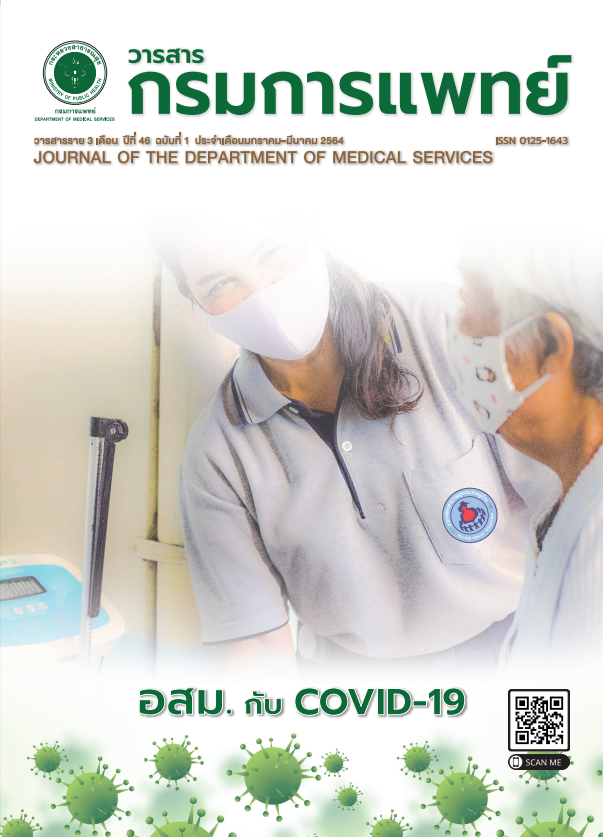The Effect of Adjusting Computed Tomography Scanner Couch Height for a Chest Phantom Scan Using Automatic Tube Current Modulation System: Radiation Dose, Image Quality and Thyroid Dose
Keywords:
Radiation dose, Computed tomography scanner, Thyroid, Automatic tube current modulation, Patient mis-positioningAbstract
Background : Automatic tube current modulation (ATCM) system plays an important role for computed tomography (CT) examinations. Thyroid is one of the more radio-sensitive organs.Objective : The aims of this research were to measure the thyroid dose received from a chest CT scan using ATCM system and to examine the impact of patient’s vertical mis - centering to the radiation dose and image quality.Method : The experiments were performed using a Philips Brilliance 64 CT scanner. A chest phantom was positioned at the isocenter of CT gantry, a surview image was taken at 180 degree angle tube position and the phantom was scanned. The couch heights were then raised and lowered by 2, 4, 6 and 8 cm, the surview images and scans of the phantom were repeated for individual couch heights. Skin doses at the thyroid were measured using Nano dot dosimeters. Volume computed tomography dose index (CTDIvol) and dose length product (DLP) were recorded from the scanner’s display and values of image noise along the scan length were measured using Image J software.Result : The surview images were magnified when the couch heights were lowered (or nearer the X-ray tube). The average mAs/ slice and CTDIvol for different couch heights were within ±7.4% compared to those for the isocenter, they were relatively increased and decreased when the couch were higher and lower than the isocenter position, respectively. These were opposite to the sizes of surview image as mentioned earlier. This might be because the ATCM software allows accurate estimation of the phantom attenuation. The average values of image noise measured for different couch heights were not significant differences from that for the isocenter, except for that when the couch was 8 cm lowered. Doses for thyroid decreased when the couch were moved away from the isocenter due to the more radiation attenuation by the edge of bow-tie filter.Conclusion : A well-centered patient positioning was very important for use of CT ATCM system, in order to achieve appropriate radiation dose and image quality levels.
References
Mulkens TH, Bellinck P, Baeyaert M, Ghysen D. Van Dijck X, Mussen E, et al. Use of an automatic exposure control mechanism for dose optimization in multi-detector row CT examinations: clinical evaluation. Radiology 2005; 237: 213-23.
Kalra MK, Rizzo S, Maher MM, Halpern EF, Toth TL, Shepard JA, et al. Chest CT performed with z-axis modulation: scanning protocol and radiation dose. Radiology 2005; 237: 303-8.
American Academy of Family Physicians. Lung cancer clinical recommendations. Available at:http://www.aafp.org/patient-care/clinical-recommendations/all/lung-cancer.html.Accessed September 9,2016.
Jaklitsch MT, Jacobson FL, Austin JH. The American Association for Thoracic Surgery guidelines for lung cancer screening using low-dose computed tomography scans for lung cancer survivors and other high-risk groups. J Thorac Cardiov Surg 2012; 144:33–8.
Smith RA, Andrews K, Brooks D, DeSantis CE, Fedewa SA,Lortet-Tieulent J, et al. Cancer screening in the United States,2016: A review of current American Cancer Society guidelines and current issues in cancer screening. CA Cancer J Clin 2016;66: 96–114.
Toth T, Ge Z, Daly MP. The influence of patient centering on CT dose and image noise. Med Phys 2007; 34:3093-101.
Habibzadeh MA, Ay MR, Asl AR, Ghadiri H, Zaidi H. Impact of miscentering on patient dose and image noise in x-ray CT imaging: phantom and clinical studies. Phys Med 2012; 28:191–9.
Wood T J, Moore CS, Stephens A, Saunderson JR, Beavis AW.A practical method to standardise and optimise the Philips DoseRight 2.0 CT automatic exposure control system. J Radiol Prot 2015; 35: 495–506.
Scarboro SB, Cody D, Alvarez P, Followill D, Stingo FC, Zhang D M, et al. Characterization of the nanoDot OSLD dosimeter in CT. Med Phys 2015; 42: 1797-807.
Zhang D, Li X, Gao Y, Xu XG, Liu B. A method to acquire CT organ dose map using OSL dosimeters and ATOM anthropomorphic phantoms. Medical physics 2013; 40: 081918.
Kirkwood ML, Guild JB, Arbique GM, Anderson JA, Valentine RJ, Timaran C. Surgeon radiation dose during complex endovascular procedures. J Vasc Surg 2015; 62 :457–63.
Li J, Udayasankar UK, Toth TL, Seamans J, Small WC,Kalra MK.Automatic patient centering for MDCT:effect on radiation dose.Am J Roentgenol 2007; 188:547-52.
Kim MS, Singh S, Halpern E, Saini S, Kalra MK. Relationship between patient centering, mean computed tomography numbers and noise in abdominal computed tomography:Influence of anthropomorphic parameters. World Journal of Radiology 2012; 4: 102-8.
Gudjonsdottir J, Svensson JR, Campling S, Brennan PC,Jonsdottir B. Efficient use of automatic exposure control systems in computed tomography requires correct patient positioning. Acta Radiol 2009; 50: 1035–41.
Kaasalainen T, Palmu K, Lampinen A, Kortesniemi M. Effect of vertical positioning on organ dose, image noise and contrast in pediatric chest CT: phantom study. Pediatr Radiol 2013; 43:673–84.
Merzan D, Nowik P, Poludniowski G, Bujila R. Evaluating the impact of scan settings on automatic tube current modulation in CT using a novel phantom. Br J Radiol 2017; 90: 20160308.
Li X, Shi JQ, Zhang D, Singh S, Padole A, Otrakji A, et al. A new technique to characterize CT scanner bow-tie filter attenuation and applications in human cadaver dosimetry simulations. Med Phys 2015; 42: 6274–82.
Downloads
Published
How to Cite
Issue
Section
License

This work is licensed under a Creative Commons Attribution-NonCommercial-NoDerivatives 4.0 International License.
บทความที่ได้รับการตีพิมพ์เป็นลิขสิทธิ์ของกรมการแพทย์ กระทรวงสาธารณสุข
ข้อความและข้อคิดเห็นต่างๆ เป็นของผู้เขียนบทความ ไม่ใช่ความเห็นของกองบรรณาธิการหรือของวารสารกรมการแพทย์



